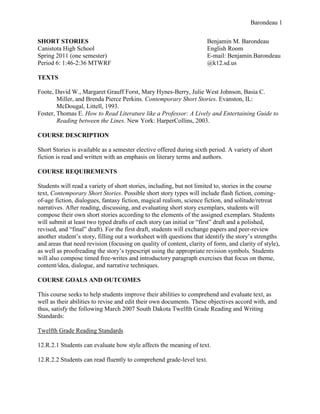
Short Stories Course Overview
- 1. Barondeau 1 SHORT STORIES Benjamin M. Barondeau Canistota High School English Room Spring 2011 (one semester) E-mail: Benjamin.Barondeau Period 6: 1:46-2:36 MTWRF @k12.sd.us TEXTS Foote, David W., Margaret Grauff Forst, Mary Hynes-Berry, Julie West Johnson, Basia C. Miller, and Brenda Pierce Perkins. Contemporary Short Stories. Evanston, IL: McDougal, Littell, 1993. Foster, Thomas E. How to Read Literature like a Professor: A Lively and Entertaining Guide to Reading between the Lines. New York: HarperCollins, 2003. COURSE DESCRIPTION Short Stories is available as a semester elective offered during sixth period. A variety of short fiction is read and written with an emphasis on literary terms and authors. COURSE REQUIREMENTS Students will read a variety of short stories, including, but not limited to, stories in the course text, Contemporary Short Stories. Possible short story types will include flash fiction, coming- of-age fiction, dialogues, fantasy fiction, magical realism, science fiction, and solitude/retreat narratives. After reading, discussing, and evaluating short story exemplars, students will compose their own short stories according to the elements of the assigned exemplars. Students will submit at least two typed drafts of each story (an initial or “first” draft and a polished, revised, and “final” draft). For the first draft, students will exchange papers and peer-review another student’s story, filling out a worksheet with questions that identify the story’s strengths and areas that need revision (focusing on quality of content, clarity of form, and clarity of style), as well as proofreading the story’s typescript using the appropriate revision symbols. Students will also compose timed free-writes and introductory paragraph exercises that focus on theme, content/idea, dialogue, and narrative techniques. COURSE GOALS AND OUTCOMES This course seeks to help students improve their abilities to comprehend and evaluate text, as well as their abilities to revise and edit their own documents. These objectives accord with, and thus, satisfy the following March 2007 South Dakota Twelfth Grade Reading and Writing Standards: Twelfth Grade Reading Standards 12.R.2.1 Students can evaluate how style affects the meaning of text. 12.R.2.2 Students can read fluently to comprehend grade-level text.
- 2. Barondeau 2 12.R.3.1 Students can evaluate text for the author’s style. 12.R.4.1 Students can evaluate the depiction of human experience in literary works from diverse cultures, locations, and time periods. Twelfth Grade Writing Standards 12.W.1.3 Students can revise a document for ideas, organization, diction, fluency, voice, and presentation. 12.W.2.1 Students can edit a document for all conventions. INSTRUCTIONAL METHODS To successfully complete the coursework for Short Stories, students will devote class time to 1) discussing and evaluating the reading assignments; 2) discussing the elements of a good short story and the elements of different kinds of short stories, as well as literary terms and literary techniques, including the use of dialogue, diction, narrative point of view, and introductory paragraphs; 3) free writing, drafting, peer-reviewing, editing, and revising short stories; and 4) timed free writing exercises. EVALUATION The instructor will evaluate students using daily work, writing assignments, quizzes, and tests. The daily work and writing assignments will be a variety of written exercises that emphasize the use of the various components of writing and reinforce the importance of those skills. COURSE UNITS I. Orson Scott Card’s Elements of a Good Story: MICE (Milieu, Idea, Character, Event) II. Literary terms: irony, theme, mood, setting, symbol, characterization, point of view, plot structure, dialogue III. First-, Second-, and Third-person Point of View IV. Use of Violence in Literature V. Flash Fiction VI. Rough Outlining, Plotting, Prewriting, Free Writing, and “Zero Drafts” (Extended Free Writing) VII. Use of Dialogue VIII. Introductory Paragraphs IX. Coming-of-age Story X. Dialogue Story XI. Fantasy and Magical Realism XII. Solitude and Retreat Narratives XIII. Science Fiction